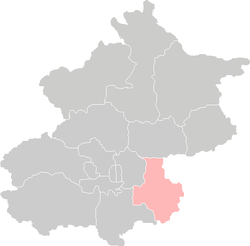Tongzhou District, Beijing
|
Tongzhou 通州区 |
|
|---|---|
| District | |

|
|
 Location of Tongzhou District in Beijing |
|
| Coordinates: 39°54′36″N 116°39′23″E / 39.91000°N 116.65639°ECoordinates: 39°54′36″N 116°39′23″E / 39.91000°N 116.65639°E | |
| Country | People's Republic of China |
| Municipality | Beijing |
| Township-level divisions | 4 subdistricts 10 towns 1 ethnic township |
| District seat | Zhongcang Subdistrict |
| Area | |
| • Total | 906 km2 (350 sq mi) |
| Elevation | 32 m (106 ft) |
| Population (2010) | |
| • Total | 1,184,000 |
| • Density | 1,300/km2 (3,400/sq mi) |
| Time zone | China Standard (UTC+8) |
| Postal code | 101149 |
| Area code(s) | 0010 |
| Website | http://www.bjtzh.gov.cn/ |
| Tongzhou | |||||||||

"Tongzhou", as written in Chinese
|
|||||||||
| Chinese | 通州 | ||||||||
|---|---|---|---|---|---|---|---|---|---|
| Postal | Tungchow | ||||||||
|
|||||||||
| Tongxian (Tong County) | |||||||||
| Simplified Chinese | 通县 | ||||||||
| Traditional Chinese | 通縣 | ||||||||
| Postal | Tungchow | ||||||||
|
|||||||||
| Transcriptions | |
|---|---|
| Standard Mandarin | |
| Hanyu Pinyin | Tōngzhōu |
| Wade–Giles | T'ung1-chou1 |
| Transcriptions | |
|---|---|
| Standard Mandarin | |
| Hanyu Pinyin | Tōngxiàn |
| Wade–Giles | T'ung1-hsien4 |
Tongzhou District (simplified Chinese: ; traditional Chinese: ; pinyin: ; Wade–Giles: T'ung1chou1 Ch'ü1, alternate spellings Tungchow Tungchou (T'ung-chou), or Tong County during 1914-1997) is a district of Beijing. It is located in southeast Beijing and considered the eastern gateway to the nation's capital. Downtown Tongzhou itself lies around 20 km east of central Beijing, at the northern end of the Grand Canal (on the junction between the Tonghui Canal and the Northern Canal) and at the easternmost end of Chang'an Avenue. The entire district covers an area of 906 square kilometres (350 sq mi), or 6% of Beijing's total area. It had a population of 673,952 at the 2000 Census, and has seen significant growth and development since then, growing to a population of 1,184,000 at the 2010 Census. The district is subdivided into 4 subdistricts, 10 towns, and 1 ethnic township.
Tongzhou was founded in 195 BC during the Western Han Dynasty under the name of Lu (路) County, although there is evidence for human settlement in the Neolithic. At the start of the Eastern Han Dynasty the character Lu by which it was known was altered by the addition of a water radical to become Lu (潞). In 1151 under the Jin dynasty Lu County was renamed Tongzhou, roughly meaning 'the place for passing through', in recognition of its importance as the land and water approach to Beijing.
In July 1937, subsequent to the galvanising Marco Polo Bridge Incident, Tongzhou became another site of determined Chinese resistance. In the Tongzhou Mutiny troops of the nominally Japanese-puppet East Hopei Army rebelled and came to the aid of hard-pressed Guomindang troops, and attacked the Japanese garrison. In the fall of Tongzhou to the Nationalists, many civilians were murdered and abused as well as captured Japanese military personnel.
...
Wikipedia
